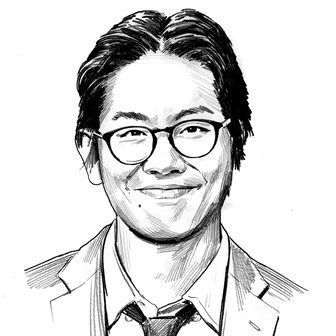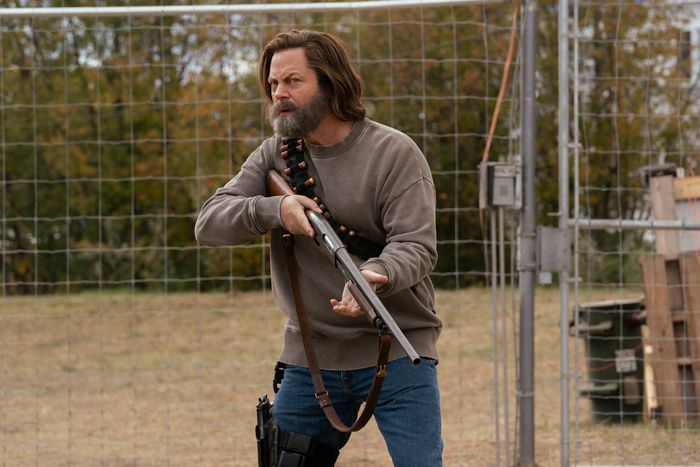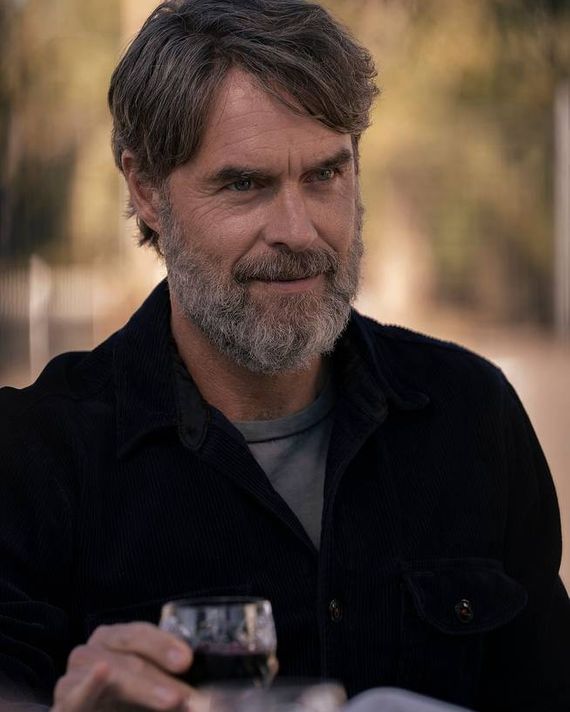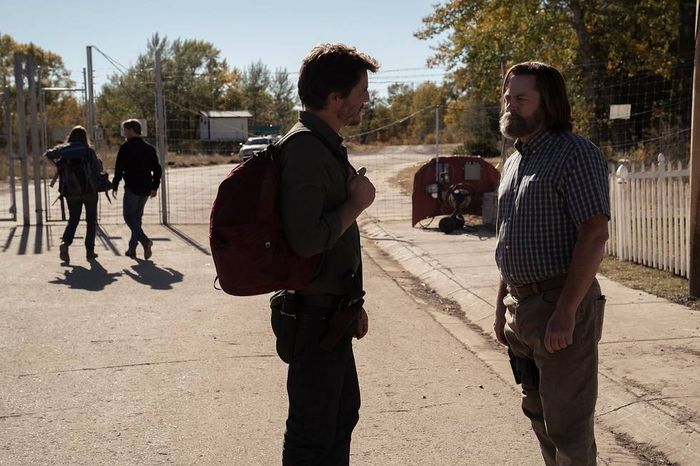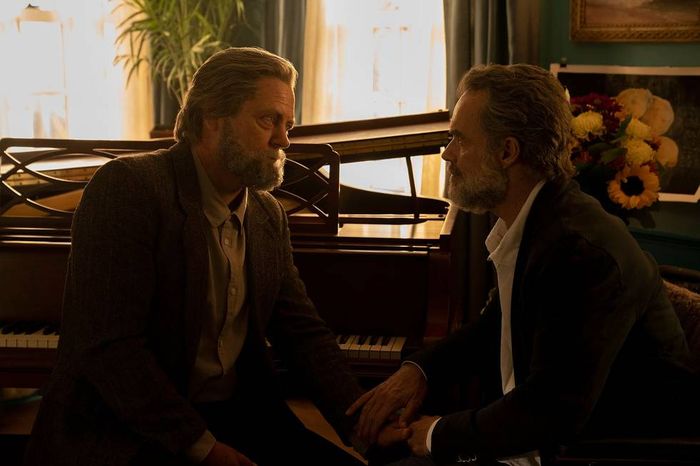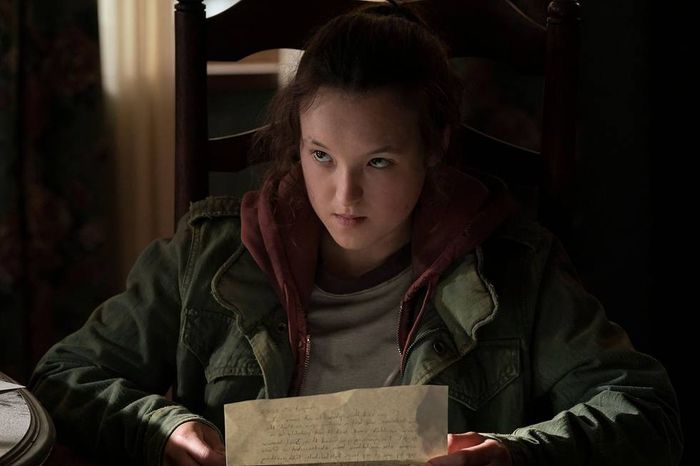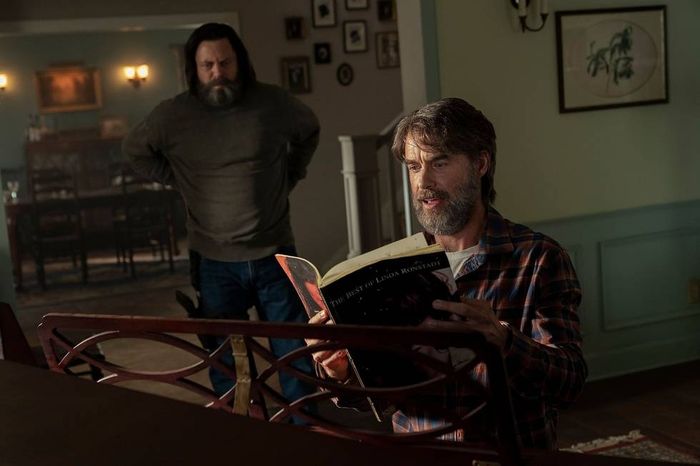
In its third episode, “Long Long Time,” HBO’s The Last of Us radically switches up its pitch. The series has injected new energy into what’s been a mostly faithful adaptation of the video game so far, primarily leaning on shrewd but gentle expansions to open up the world and narrative: a 1968 talk-show interview predicting the end of humankind via fungus, an Indonesian lab flashback documenting the origins of said infection. But in “Long Long Time,” showrunner and episode writer Craig Mazin stretches the adaptation beyond its original bounds and introduces a motif that elevates the adaptation beyond its source material.
The hour begins somewhere outside Boston, as Joel and Ellie (Pedro Pascal and Bella Ramsey) collect themselves following their harrowing escape from the Massachusetts State House and the loss of Tess. The opening minutes suggest a slower pace as the duo make their way on foot across Massachusetts; after a brief pit stop at a long-abandoned gas station, Joel heeds Tess’s directive to take Ellie to the town of Lincoln. It’s home to Bill and Frank, survivors who maintain a line of communication with the smugglers through a radio signal playing decade-specific music hits, as heard in the first episode.
Then we break off from Joel and Ellie’s narrative. The episode shifts its attention to the two residents of Lincoln, jumping back in time to sketch out the love story between a doomsday prepper (Bill, played by Nick Offerman) and an artist (Frank, played by Murray Bartlett), who meet shortly after the outbreak. What transpires is a defining episode of the adaptation, following Bill and Frank from their first meeting through their last day on Earth, when the two make the decision to go out peacefully on their own terms.
A Break From Fear
In keeping with the video game’s relentless tone, Bill and Frank’s story is significantly grimmer in the source material. As Joel and Ellie, you first encounter Bill, a solitary, bitter, angry human being, after navigating his network of booby-traps set up across town. You never really meet Frank, only later finding his body suspended from the ceiling; he’d hung himself after getting bitten. Through notes and environmental clues, you learn Bill and Frank once had a working partnership that turned sour as Frank grew to resent Bill’s controlling nature. Whatever relationship Bill might have had with Frank, sexual or romantic, is mostly implied.
For Mazin, the choice to explore a different story for the duo was rooted in an effort to fully consider the adaptation on its own terms. “In talking with Neil” — Druckmann, who co-created the game and the show — “I just said, ‘Look, we have an opportunity here to do something very different,’” he says. “Because you’re tied to Joel’s perspective in the game, you meet Bill, you see what his deal is, he assists you, then it’s over. The show doesn’t have to do that. We can go wherever we want.”
The idea was to introduce a breather after the intensity of the first two episodes. “We needed a break from fear,” says Mazin. That Bill had successfully built out a survivalist haven at the end of the world offered the chance to explore an intriguing question: Once you’ve removed all threats and established a sense of safety, what do you do with your life? Frank’s arrival provides Bill a pathway to that answer, and the arc of their relationship adds a rare hopeful entry to the pantheon of post-apocalyptic storytelling.
‘Buddy, You’re Going to Calgary’
We meet Bill in a bunker beneath his house, waiting out soldiers tasked with vacating Lincoln. Definitely paranoid and probably a conspiracy theorist, Bill’s prepping turns out to be fruitful in this universe: The world of The Last of Us did end, after all, and the government did end up exterminating innocent civilians in attempts to curb the outbreak.
To Mazin, Bill was someone grappling with a deep sense of shame who had limited himself to the bare necessities well before the fall of civilization. “He’s closed himself off from everybody,” Mazin says. “A man who wasn’t merely closeted sexually, but closeted completely. All he knows is how to keep himself preserved and alone and therefore safe, emotionally and physically.”
Bill might have limited himself to the bare necessities, but he also exhibits an epicurean delight — the kind of guy who appreciates sturdy fence construction as much as a good bottle of wine. The production team originally approached Con O’Neill, who played engineer Viktor Bryukhanov in Mazin’s previous series, Chernobyl, for the role. “I was pretty invested in the notion that if we’re gonna be telling the story of two middle-aged gay men, then it would probably be good to have two middle-aged gay actors doing it,” says Mazin, who notes many creatives involved in the adaptation were middle-aged, married gay men. “I was maybe slightly more insistent about that than a lot of the people around me.”
But O’Neill’s gig as Izzy Hands on Our Flag Means Death rendered him unavailable. That’s when producer Carolyn Strauss suggested Offerman, whom Mazin knew casually. “I figured, Well, if we’re gonna open this up, that’s where you go. I sent him the script and said, ‘Nick, if you don’t like it, I’ll never send you anything else ever again, because it won’t be better than this,’” he recalls. But Offerman also had a scheduling conflict. “I read the script, and I was like, ‘Oh no, what a dilemma,’” Offerman remembers. “Thankfully I have a perspicacious wife named Megan who I asked to read it, and she said, ‘Buddy, you’re going to Calgary.’”
Frank arrives as Bill’s opposite, falling into a pit Bill set up as a defensive measure at the perimeter of the town. Armed with a shotgun, Bill comes across as a “shoot first, ask questions later” kind of guy, but for whatever reason decides to let Frank into his house, lets him use the shower, and makes him lunch. “Bill’s instinct, in a very clear-headed way, is ‘Okay, I’m not gonna shoot you. This encounter will last about 40 more seconds, then you’re gonna go,’” says Mazin. “And Frank, uh, just doesn’t leave.”
An artist who, in Mazin’s words, “has very little in the way of core shame, perhaps none,” Frank needs more than the bare necessities to find meaning in catastrophe. “What he needs is to create beauty, and in so doing, begins to open Bill up to the world,” says Mazin. “So much of the story is asking what happens to a guy like Bill when somebody like Frank comes along.” For The Last of Us’s producers, that somebody was Murray Bartlett, who auditioned for Frank before the first season of The White Lotus had aired, a show for which he’d go on to win an Emmy. In keeping with the production’s approach to casting Joel and Ellie, Offerman and Bartlett never screen-tested together.
“The thing about Frank is that he can endear people enough that they don’t shoot him,” Bartlett says. “The fact that Bill doesn’t immediately shoot, it’s a way into the possibility of a connection. Initially, Frank doesn’t even know what that is; he senses something, but at that point he’s just driven by needing to survive and eat. He sees a crack in the armor with Bill that he works on, and once they both let their guards down a little, it’s not long before the door flies open.”
A Song About a Long-Term Ache
It’s Linda Ronstadt who opens that door by way of her 1970 song “Long Long Time.” After finishing lunch — rabbit paired with beaujolais — a pregnant pause develops, with Bill and Frank both unclear on what happens next. Frank doesn’t want to leave, while Bill grapples with how to handle the rest of the interaction and the probability of being alone again. “Every part of him wishes that Frank would stay,” says Mazin. “But what Bill also feels inside is that he himself is not a lovable person. Then this thing happens with the song, and that’s where the wall comes crumbling down.”
Finding the right tune on which to hang Bill and Frank’s encounter presented Mazin with a unique challenge. In addition to something that could be played on the piano both well and terribly, the showrunner was searching for a song about “a long-term ache — the sadness of somebody saying, ‘I wish, but oh, well, I shall be forever alone.’
“Man, I just couldn’t find the perfect song,” he continues. “I texted my friend Seth Rudetsky, who hosts the Broadway channel on SiriusXM radio. He has an encyclopedic knowledge of music. I said, ‘Here are all the things I’m looking for. Do you know a song that would fit the bill?’ Within 30 seconds, he texted back with ‘“Long Long Time,” Linda Ronstadt.’ I played it and was like, ‘That’s the song.’”
To buy a little more time after their lunch, Frank marvels at the grand piano nearby. Rifling through songbooks and finding one for Ronstadt, he starts playing “Long Long Time” terribly, prompting Bill to take over. A spark is lit, the two kiss, and the rest of their lives begins.
An Enclave of Normalcy
After the scene at the piano, “Long Long Time” drifts across the years over a series of flash-forwards. Bill and Frank build a home and a life together, establish a link with the outside world through a trading partnership with Joel and Tess, and grow older.
Their storyline takes place entirely in Lincoln, Massachusetts, Bill’s hometown turned doomsday stronghold, complete with security cameras, electric fencing, and a basement armory. The setting also functions as an idyllic retreat in contrast with the ruin that’s defined the series so far: white picket fences and pristine lawns; a modest clapboard chapel. Built on a few acres of land in Alberta, The Last of Us’s Lincoln somewhat fittingly sits on the former site of a small town wrecked by floods. Following the disaster, the government leveled the place, leaving behind nothing but a few streets and sidewalks. Enter production designer John Paino and his team.
“We were going for almost an archetype of Americana,” he explains, citing the tiny hamlets dotting New England — where you’d find little more than a few houses, some stores, and a single stoplight — as inspiration. “The whole episode is a respite, an enclave of normalcy in the midst of all the horror.” The set of exteriors was constructed on a brisk television schedule, somewhere between six to twelve weeks, according to Paino. Everything within the gates was built from scratch, from the shells of the houses and their driveways to the life-size Civil War monument at the center of town. Because Alberta is a tundra, they had to truck in greens from Vancouver to replicate New England’s sense of foliage, an essential nod to The Last of Us’s visual theme of nature reclaiming the earth. To mark the passage of time, they leaned on practical greenery, introducing more weeds to the fences and the town’s various structures. With some exceptions, the interiors, including Bill’s bunker and the insides of his house, were built on a soundstage.
There’s an implied backstory baked into Bill’s sizable home. “My headcanon would say that Bill was the only child of a woman whose husband probably died young from a heart attack,” says Mazin. “He’s a weird kid and he’s a weird adult; his mother probably died a while ago, but he hasn’t changed anything.” Paino took that idea a step further: “They were one of the first settlers, and if you know the history and the architecture, their house is always the biggest and the closest to the middle of the town. And the residents tend to keep their houses like a museum.”
When Frank arrives, it’s not just Bill’s internal world that opens up but his hermetically sealed external world as well, as the former encourages the latter to tend to their house, and the town, with more attention and care. As time passes, we see more flowers, whitewashed-exterior walls, and more art around the house, which we later see Frank painting in a sunlit vestibule near the back of the structure. For Paino, the shift expresses Frank’s philosophy around survival. “It’s not so much keeping up appearances,” he says. “They’re living out their entire lives within those gates. They have chores, but they get bored too. It’s a sense that they only have so much time on this planet, and if they can make things better, even if it just means planting flowers, that’s a survival mechanism too.”
That the look of the town becomes less kempt as Bill and Frank age carries a symbolic weight as well. “Frank comes in, things get a little nicer, things get a little better,” says Paino. “But as Frank’s health degrades, they’re not keeping up with that so much. It’s a good metaphor for our life spans: The house becomes a different kind of museum. It becomes a crypt.”
A Successful Life That Still Ends in Death
Based on the foreboding tone established in the first two episodes and what happens in the game, there’s an ambient assumption that things will eventually turn sour, or at the very least, something very bad happens to the couple. And that almost occurs when Bill gets injured after an attack on the town by raiders. But the episode completes its subversion of those expectations by flashing forward once again, this time to the narrative’s present, revealing a Bill and Frank that made it to old age. It’s then that they finally meet their end in the post-apocalypse, not by infection or murder but by sickness and choice: Frank, weakened by a natural illness, decides to spend his last day on earth with a wedding and a meal that will end with tranquilizers. Ultimately, Bill opts to take his own life alongside Frank.
“I wanted to embrace the notion of a successful life that still ends in death,” says Mazin. “It was a chance to show what a relationship might look like over the course of time and to give people a sense that things could actually work out. Look, we all end up dead no matter what, pandemic or not, but you can get to the end of your life and be happy.”
A Rosetta Stone for The Last of Us
The episode wraps on Joel and Ellie, who reach a Lincoln in disrepair: The flowers in front of Bill and Frank’s house have died and the leaves haven’t been raked. Entering the house, they find a letter for Joel from Bill informing him of their fates and imparting the latter’s particular brand of philosophy.
“I used to hate the world, and I was happy when everyone died,” Bill writes. “But I was wrong, because there was one person worth saving. That’s what I did. I saved him. Then I protected him. That’s why men like you and me are here. We have a job to do. And God help any motherfucker who stands in our way.”
Bill’s letter will reverberate across the rest of the season. “I think of Bill and Frank as a kind of Rosetta stone for The Last of Us,” says Mazin. “I wanted to really explore the nature of love. The way some people love outwardly through nurturing and the creation of beauty, and how other people are more defensive in their love — that their job is to keep the other person alive. That dichotomy repeats itself in all the relationships across the show.”
He adds: “Joel and Ellie really begin their story here.”


